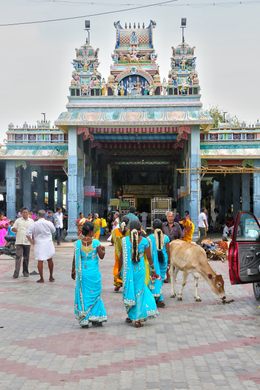AO Edited
Arulmigu Kulasai Mutharamman Temple
Every year, massive crowds flock to this 300-year-old temple to celebrate a unique, goddess-centric Hindu festival.
In the quaint Tamil Nadu village of Kulasekharapatnam (sometimes spelled Kulasai), 400 miles south of Chennai, a towering 300-year-old temple sits just steps from the Laccadive Sea. In the temple’s interior, idols of local Hindu goddess Mutharamman and god Swamy Gnanamoorthiswarar sit next to each other, ready to accept any offerings from followers. A sacred neem tree, Azadirachta indica, can also be found on the temple grounds.
Inside Sri Mutharamman Temple (another name for the site) are three mandapams, or pillar-lined pavilions or halls, an architectural feature commonly found in Hindu temples across the subcontinent.
Most of the time the temple serves as a quiet place for religious prayer and reflection, but every year the Sri Mutharamman Temple hosts an elaborate 10-day festival celebrating the Hindu holiday of Dussehra (sometimes spelled Dasara or Dashain) or Vijayadashami.
Dussehra marks the hero Rama’s victory over the 10-headed demon king Ravana. The story of Rama, who is a reincarnation of the Hindu god Vishnu, is chronicled in the Hindu epic the Ramayana. In essence, Dussehra celebrates the triumph of good over evil and marks the beginning of India’s festival season. Several weeks after Dussehra, the Hindu holiday of Diwali is held, north India’s largest (and perhaps the country’s most ubiquitous) festival. Whereas Dussehra celebrates Rama’s victory, Diwali marks the hero’s return home.
In Kulasekharapatnam, Hindu worshippers partake in a 41-day fast ahead of Dussehra. During the final 10 days of their fast, devotees dress up as Hindu gods and goddesses. Some embody the fierce Kali, who wears a necklace of severed heads and is often depicted with four arms. Others dress as local gods and goddesses, like the temple’s own Swamy Gnanamoorthiswarar and Mutharamman.
Mutharamman is believed to be an incarnation of Durga, another fiery, severed-head-wearing Hindu goddess. Durga is also connected to Kali, who is sometimes considered Durga’s mother.
Once clad in their elaborate costumes, devotees go door to door asking for alms, which are then donated to the temple at the end of the festivities. During the festival, millions of people come to the small town for the celebration.
On the final day of Dussehra, a huge crowd gathers on the beaches of Kulasekharapatnam for one final spectacle. While Dussehra usually marks Rama’s victory, in Kulasekharapatnam, the holiday celebrates another victory: that of, the Hindu goddess Magisasura Mardini killing the buffalo-headed Magisasura.
The 10-day Dussehra festival in Kulasekharapatnam still celebrates the triumph of good over evil, but instead of a man’s victory, here that conquest is a goddess’s doing.
Know Before You Go
To get there, you can fly into either Trivandrum International Airport (TRV) or Tuticorin Airport (TCR). From there, catch a train to Tiruchendur (where you'll likely want to stay). Hop on readily available public transport, like buses or taxis, to reach Kulasekharapatnam.
Kulasai Dasara aligns with the nationwide Dussehra festivities, usually taking place between September and October, depending on the local religious calendar. Ensure you check the exact dates for the year you plan to visit.
























Follow us on Twitter to get the latest on the world's hidden wonders.
Like us on Facebook to get the latest on the world's hidden wonders.
Follow us on Twitter Like us on Facebook